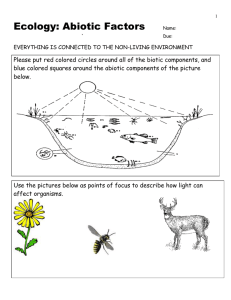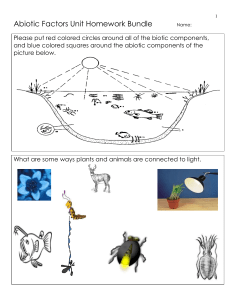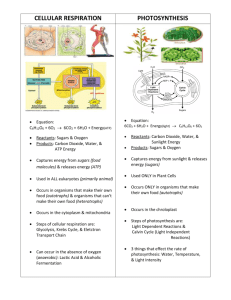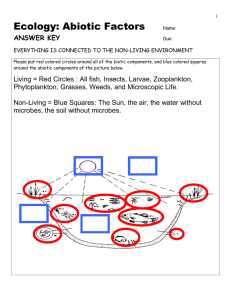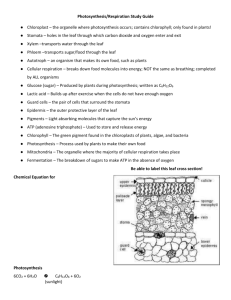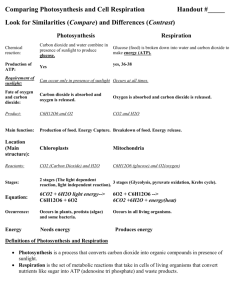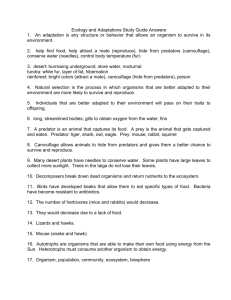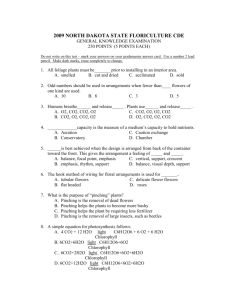Ecology: Abiotic Factors
advertisement
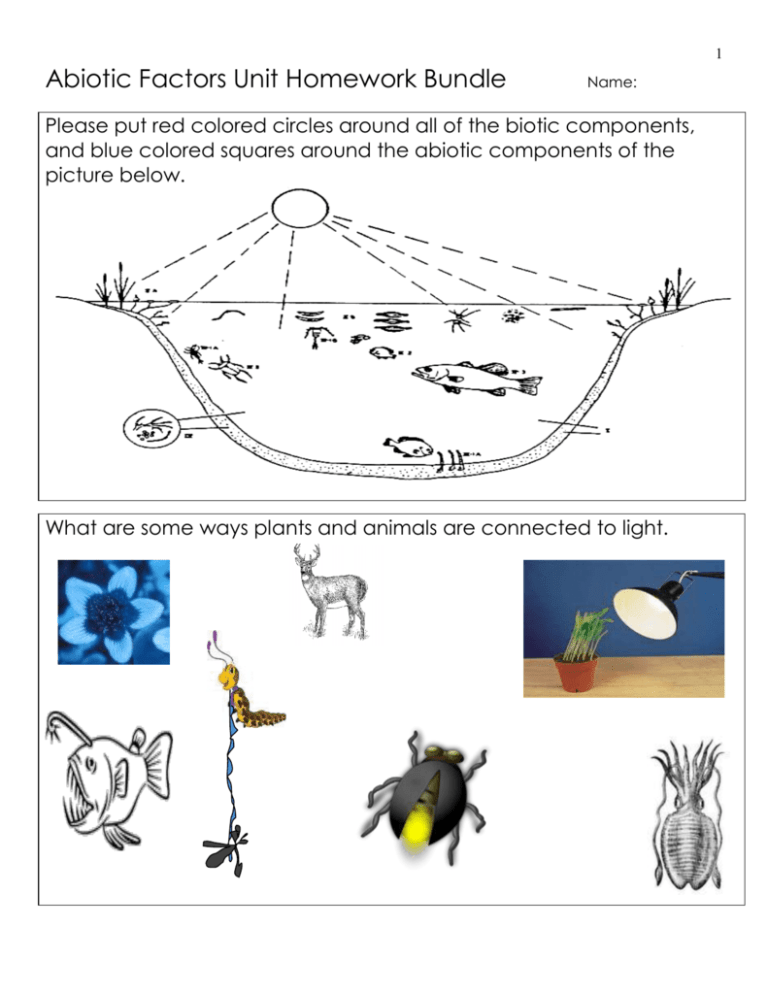
1 Abiotic Factors Unit Homework Bundle Name: Please put red colored circles around all of the biotic components, and blue colored squares around the abiotic components of the picture below. What are some ways plants and animals are connected to light. 2 Please describe the difference between a physical and behavioral adaptations based on how you thermo-regulate on a cold winters day. Describe how you have a range of tolerance when it comes to temperature. Please use the words below in your discussion of this topic. Hypothermia Hyperthermia Why is this turtle sitting on a log? Explain using some terms discussed in class. 3 Use the picture below to describe some of the advantages and disadvantages to having warm and cold bloodedness? Warning! Two Part Question. Please add desert plants and animals to the scene below. Provide text around your sketches that describe how these organisms are adapted to survive the high temperatures, and low moisture. 4 Please tell me about this organisms and its relationship to the nonliving environment. What are the positives and negatives of wind? Please write a short paragraph explaining your answer. Please describe how plants and animals utilize wind using the pictures below. 5 Please describe the type of seed dispersal below. Please describe Island Biogeography theory based on the map below. Please describe using text which Island will most likely exhibit the following. ◊ 1) Most migrations and fewest extinctions. ◊ 2) Fewest migrations and most extinctions, ◊ 3) Describing using multiple arrows were island hopping may occur. (Check each diamond when complete) 6 Are forest fires good? Please answer this question in the space below. Please label 1-8 in the picture below. Some of the terms from the previous word-bank will help you. Encore Water Cycle! 7 Please write out the equation for photosynthesis in the boxes below. Which of the following is the correct equation for photosynthesis? 1 A) 6O2 + 6H2O + light energy = C12H6O6 + 6O2 2 B) 6CO2 + 6H2O + sugar = C6H12O6 + 6O2 3 C) 6CO2 + 6O2 + light energy = C6H12O6 + 6H2O 4 D) 6CO2 + 6H2O + light energy = C6H12O6 + 6H2O 5 E) 6CO2 + 6H2O + light energy = C6H12O6 + 6O2 Please write out the equation for cellular respiration in the boxes below. Which of the following is the correct equation for cellular respiration? 1 2 3 4 A) C6H12O6 + 6H2O = Released energy + 6CO2 + 6H2O. B) C6H12O6 + 6O2 = Released energy + 6CO2 + 6H2O. C) C6H12O6 + 6O2 = Released energy + 6O2 + 6H2O. D) C12H6O6 + 6O2 = Released energy + 6CO2 + 6H2O. 5 E) C6H12O6 + 6CO2 = Released energy + 6O2 + 6H2O. 6 Please describe the oxygen carbon-dioxide balance based on the picture below. Be very specific, using the equations for both photosynthesis and cellular respiration. 8 Describe the nitrogen cycle below on the lines and fill in the blanks on the picture. 9 Please describe acid rain in the space below. Make reference to the pH scale in and around the boxes. What are some solutions that are acidic, neutral, and basic? Please draw arrows showing how phosphorus travels through the living and non-living world in the phosphorus cycle. 10 Please label the following pictures as olgiotrophic, mesotrophic, eutrophic, or eutrophication. *Also provide a brief description of each one…. 11 Please describe Eutrophication below. Use the pictures as a resource in your response. 12 What can you tell me about each of the pictures below? Provide an example from the unit. 13 1 2 3 4 5 6 7 8 9 10 11 13 12 14 15 16 18 20 23 17 19 21 22 24 25 26 27 28 29 30 31 32 33 34 35 36 37 Possible Answers: abiotic, acid, adaptation, biogeochemical, biogeography, biological, biotic, carbon, coldbloodedness, condensation, dispersal, eutrophic, eutrophication, evaporation, evapotranspiration, hibernation, hyperthermia, hypothermia, light, lightenergy, mesotrophic, moisture, nitrogen, oligiotrophic, percolation, phosphorus, photo, photosynthesis, physiological, pollination, precipitation, respiration, shivering, temperature, thermoregulation, tolerance, warmbloodedness, wate ACROSS DOWN 3 - This is when water that is so heavy it falls as liquid / solid. 5 - Having a body temperature that is to high that may cause heart failure, among other problems and death 7 - Wind, water, animal, and tension are all 1 - Being inactive during winter, and lower metabolism 2 - The circulation of carbon from the atmosphere into organisms (biotic) and back again (abiotic). (___________ cycle) 4 - A common nutrient in nutrient pollution. types of seed _____________ 10 - Type of rain that has a lower pH from air pollutants. 11 - Processes whereby certain organisms obtain energy from organic molecules. (Cellular ______________) 15 - This is when a substance changes from a liquid state to gas state (requires energy). 16 - Prefix for the word light 18 - The slow movement of water through the soil 20 - Island __________________ is the study of rates of colonization and extinction of species on islands. 26 - The transferring of pollen (plants sex cells) from one plant to another 27 - Name for a lake or river with moderate productivity 29 - All organisms have a range of ____________________ to the abiotic factors 30 - Of, pertaining to, or produced by life or living organisms. 31 - Warm and cold abiotic factor 32 - The type of thermoregulation that you can control 33 - The wettest of the seven abiotic factors 34 - This cycle circulates nitrogen from the air, to the soil, to organisms, and then back to the air. (_________ cycle) 35 - The brightest of the seven abiotic factors 36 - The ability of an organism to keep its body temperature within certain boundaries 37 - This is when water vapor (gas) turns back to a liquid. (energy required / cold) -cloud formation 14 6 - A process whereby an organism becomes better suited to its habitat. 8 - This is when water is released by plants into air 9 - Process where muscles contract and relax when it is cold, this generates heat 12 - Name for a lake or river with high productivity 13 - The __________ cycle is the continuous movement of water on, above, and below the surface of the Earth 14 - When organisms can’t regulate their internal temperature 17 - A decrease in the core body temperature to a level at which normal muscular and brain functions are impaired 19 - 6CO2 + 6H2O +_________________ = C6H12O6 + 6O2 21 - When oxygen is removed from a water body by bacteria 22 - Another name for the word non-living 23 - Maintaining a warm body temperature independent of environmental conditions. 24 - This is a life, Earth, change atoms, repeating event (_____________________ cycle) 25 - The answer for this question is biological 26 - A process that converts carbon dioxide into organic compounds, especially sugars, using the energy from sunlight. 28 - Name for a lake or river with low productivity 15 16


